Phulkopir roast aka niramish phulkopir roast is a rich, creamy, flavoured and mildly spicy Bengali cauliflower curry which is crazily popular among Bengalis. It is a pure niramish recipe, I mean no onion no garlic recipe. Phulkopir roast recipe is a special dish which is occasionally prepared in every Bengali house during special occasions like Durga puja and other festivals in winter when fresh cauliflower is easily available in the market. Even it is one of the most frequently served dishes in authentic Bengali restaurants and by the caterers. In this preparation, fried cauliflower florets are cooked in cashew-poppy seeds-coconut based gravy with some peas, ghee and Bengali garam masala. It is one of the versatile dishes which can be relished with basanti pulao, plain rice and even with luchi, paratha, roti etc.
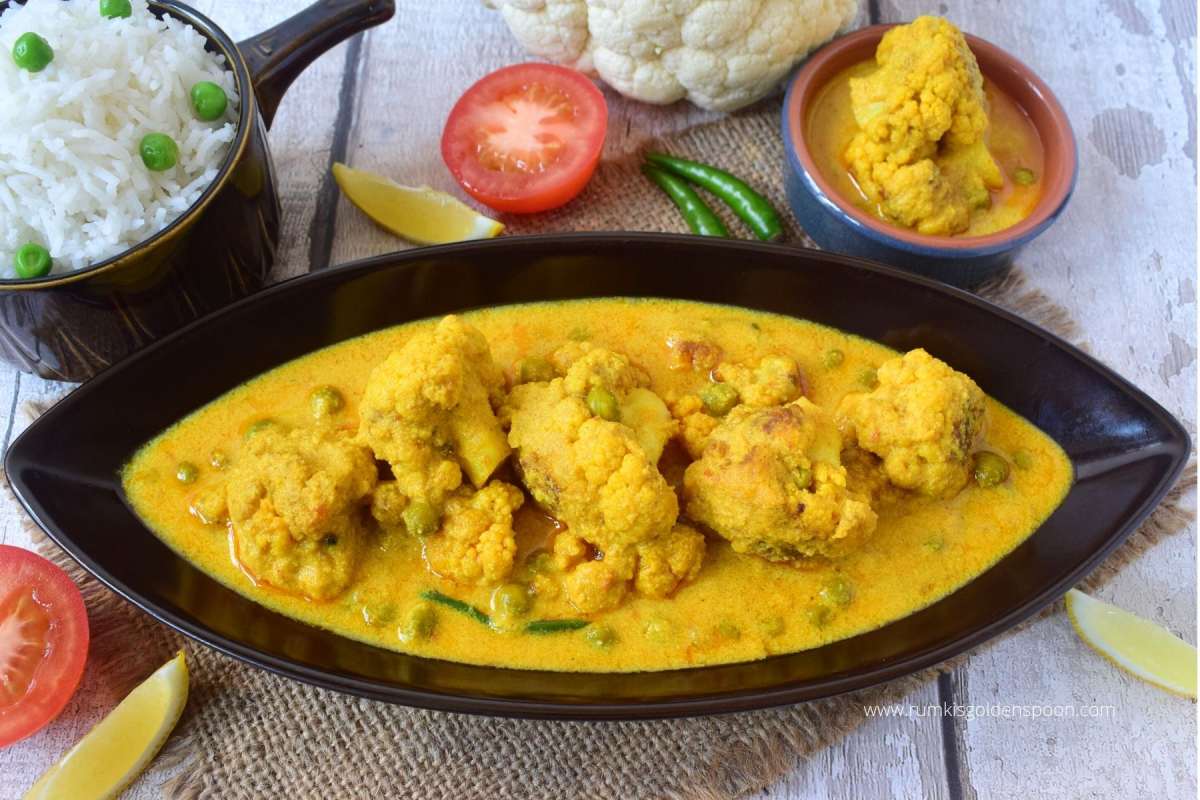
Table of Contents
About the recipe
Tips and Suggestions
How to make Phulkopir roast (step wise photos)
Recipe Card
What is Phulkopir roast?
Phulkopir roast, the name sounds like an oven roasted recipe, but no roasting is done in Bengali style cauliflower roast. But still it is named so. It is completely prepared on stove top in a kadai or pan. The cauliflower florets are shallow fried in ghee before adding to the gravy. It may be named so because of this reason. Even the Bengali chicken roast is completely prepared in kadai and no roasting is done in oven. Though these recipes are not prepared by roasting in oven but still they taste incredible, and you won’t stop licking your fingers.
Phulkopir roast recipe is a niramish recipe aka vegetarian recipe prepared without onion and garlic. It is frequently prepared on vegetarian days and puja occasions like durga puja, kojagari puja and kali puja.
Bengalis are scrupulous about vegetarian food and they split it into two different parts. One division is called satvik food where onion, garlic and even masoor dal are prohibited along with nonvegetarian items. In another division, normal vegetarian dishes are prepared using onion and garlic. Onion and garlic are considered as rajasik food which produces heat in our body and inflame our passion, incomprehension.
The preparation of phulkopir roast recipe is quite like the phulkopir rezala recipe except the usage of onion and garlic in rezala. Both taste similar to each other but are not the same. Phulkopir rezala is a perfect dish which you can enjoy other than vegetarian days. I will get back to you with this recipe shortly. Stay tuned.
Whenever I talk about phulkopir roast, it always makes me feel nostalgic. As a bong, I have grown up eating this delight every year and have never got bored with it till now. I still remember how my mother used to prepare it during Durga puja. She used to serve it mostly as a side with phulko luchi or with basanti pulao and we used to devour that with eternal pleasure. I have learned this Bengali veg recipe from her.
Niramish phulkopir roast is a very popular dish but not a signature dish of Bengal. Every family has their own recipe according to their own preferences in taste and texture. Few people prepare it as white gravy whereas few others as yellow. Few people prefer to prepare the dish completely in ghee, few in refined oil and few using combination of both. Many people use milk or cream for the gravy, and many uses only water. In this way, every house has their own style of preparing this scrumptious dish.
Today, I am going to share my yellow gravy phulkopir roast recipe with you. Addition of turmeric powder to the dish is completely up to you whether you prefer yellow gravy or white. I personally like yellow gravy for the dish and hence added turmeric powder. In this preparation, I have manipulated the ingredients in such a way to make a perfect balance of taste and health of the dish without compromising in taste.
Phulkopir roast aka niramish phulkopir roast is a very simple and easy recipe. It requires very limited ingredients which are easily available in any Bengali kitchen pantry. It is a pure Bengali delicacy and you will get the essence of Bengal in it. The best part of the recipe is that you don’t need to drop your tears for slicing onions. It could be a great option for any small party or family get together.
Phulkopir roast with step by step photos and instructions have been provided in the ‘Instruction’ section of the recipe. I have included all the tips and tricks below. If you follow each step of my recipe precisely then you will get phulkopir roast recipe with perfect flavour and consistency which will even taste better than the ones in restaurants.
Tips to prepare perfect Phulkopir roast
- Always fry the cauliflower florets separately before adding to the gravy.
- Use refined oil and ghee both to fry the cauliflower florets for better flavour
- Don’t skip the whole spices from the recipe. It induces nice aroma into the oil.
- Beat the yogurt thoroughly before adding, to resist it to curdle.
- Addition of green pean is optional but it adds colour to the dish.
- Phulkopir roast is slightly sweet in taste. Don’t forget to add sugar into the gravy.
- Don’t skip the Bengali garam masala powder and ghee from the recipe. It gives the authentic Bengali flavour of the dish.
How to serve Phulkopir roast?
According to me, aloo phulkopir roast is one of the most versatile curries. It can be accompanied with luchi, paratha aka porota, ruti and even with plain rice, basanti pulao, Bengali fried rice. But, I must say it tastes best with Bengali mishti pulao and phulko luchi.
How to make Phulkopir roast?
To prepare phulkopir roast, first cut the cauliflower florets into even pieces and wash them. Then marinate the cauliflower florets with salt and turmeric powder. Keep it aside.
On the other hand, soak poppy seeds and cashew nuts in hot water for half an hour. Then strain the water and transfer it into a jar of a grinder. Add grated fresh coconut and little water and close the lid. Pulse it to a smooth paste and keep it aside.
Then add tomato chunks into a jar of a grinder and close the lid. Pulse it to a smooth paste and keep it aside.
Put a pan on flame and allow it to become completely dry. Then add oil and ghee into the pan and wait until it is hot. Add the marinated cauliflower florets and fry them over medium flame for around 15 minutes until it loses its crunch and brown spots occur on it. Strain the cauliflower florets out and keep it aside.
In the same pan, add some more ghee and allow it to melt. Once it is hot, add whole spices – bay leaf, cloves, cinnamon stick, cardamoms and let them crackle.
Add tomato paste into the pan and give a nice stir. Cook in medium to low flame for 3-4 minutes until it releases oil.
Then put the flame in low and add ginger paste into the pan and give a nice stir. Cook it in lowest flame for 2-3 minutes until the raw smell if ginger goes away.
Add salt, turmeric powder, red chilli powder and give a nice mix. Cook it in low flame for few more seconds.
Put the flame in low and add the whipped yogurt into the pan and give a nice mix. Add cumin powder and mix it well. Cook it for couple of minutes until it releases oil.
Add the poppy seeds-coconut paste into the pan and mix it well. Cook it in medium low flame for 6-7 minutes until the masala releases oil. Stir in regular intervals.
Add boiled peas, raisin, green chillies into the pan and give a nice mix. Cook it in low flame for another couple of minutes.
Then add water into the pan for gravy and give a nice stir. Add sugar and give a nice mix. Put the flame in high until the gravy starts boiling.
Then put the flame in low and add the fried cauliflower chunks into the pan. Cook it for another 10-12 minutes.
The consistency of the phulkopir roast gravy is thick. But you can prepare it according to your own preference.
At the final stage of cooking, add bengali garam masala powder (a ground spice mixture which contains equal portion of cardamom, cinnamon and cloves) and ghee (Clarified butter), one by one into the pan. These elements enhance the flavour of the dish to next level.
Check the salt of the curry and add if required. Simmer the gravy for 10-15 more seconds and then switch off the flame.
Many Bengali veg recipes have already been shared in my previous posts. You can check few of them like
Chanar Dalna
Aloo Posto
Shorshe Begun
Doi Potol
..And Many more…
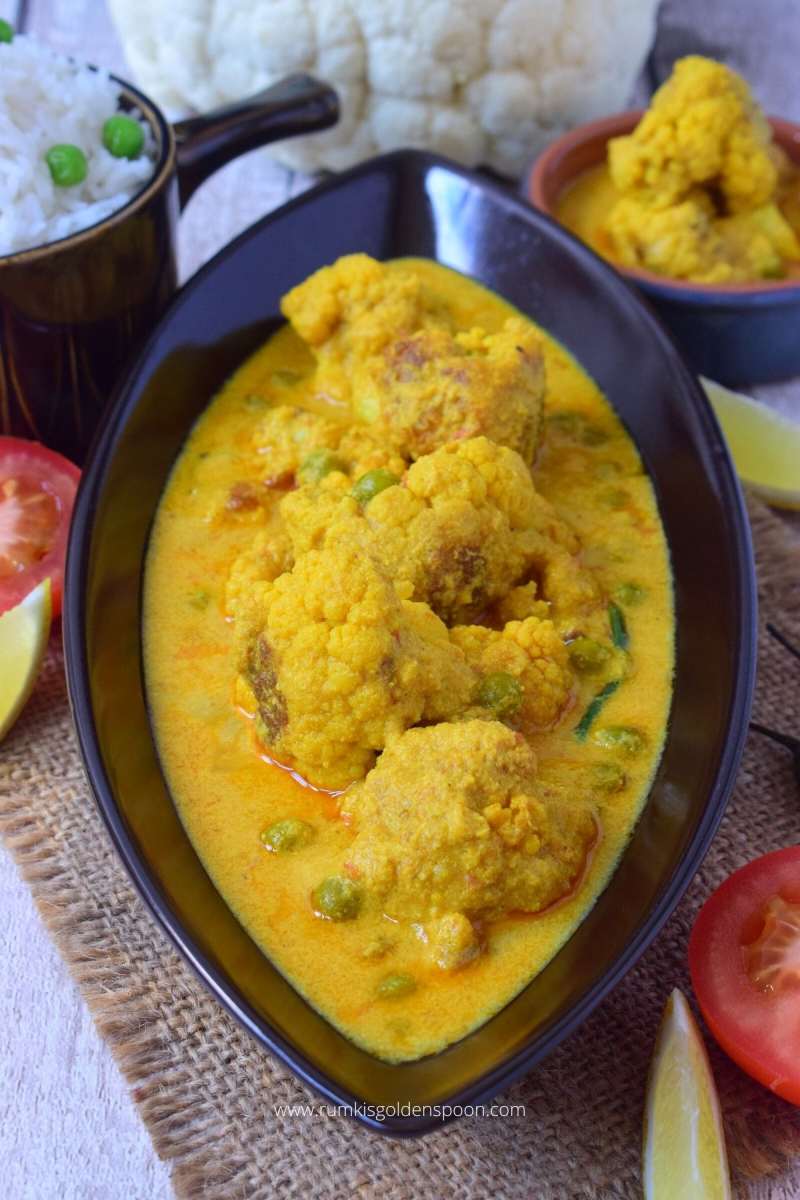
Ingredients:
1 cup = 250 ml
To marinate the cauliflower
- 1 medium Cauliflower (Phulkopi), cut into medium florets
- ½ teaspoon Salt
- ½ teaspoon Turmeric powder
For the coconut paste
- 1 tablespoon Poppy seeds (Posto)
- 15 Cashew nuts
- ¼ cup grated Coconut, fresh
- 2-3 tablespoons Water
Other ingredients for Phulkopir roast
- 2 Tomatoes, for paste
- ½ cup boiled green Peas (Optional)
- ½ tablespoon Ginger paste
- 3-4 green Chillies
- 1 tablespoon Raisin
- ¼ cup Yogurt, whipped
- 3 Cardamoms (Elaichi)
- 4 Cloves (Laung)
- 1 inche Cinnamon stick (Dalchini)
- 1 Bay leaf (Tejpatta)
- 1 teaspoon Turmeric powder
- ½ teaspoon red Chilli powder
- ¼ teaspoon Cumin powder
- 1 teaspoon Bengali Garam masala
- 2 teaspoons Sugar, adjust accordingly
- 1 teaspoon Ghee (Clarified butter)
- Salt to taste
- 3 tablespoons Oil for cooking
- 2 tablespoons Ghee (Clarified butter) for cooking
- 1½ cups Water for gravy
Instructions:
- Wash and cut the cauliflower florets into medium size even pieces. Add ½ teaspoon salt, ½ teaspoon turmeric powder and mix them evenly so that each cauliflower florets can get coated. Keep it aside.

- On the other hand, soak 1 tablespoon poppy seeds and 15 cashew nuts in hot water for 30 minutes.
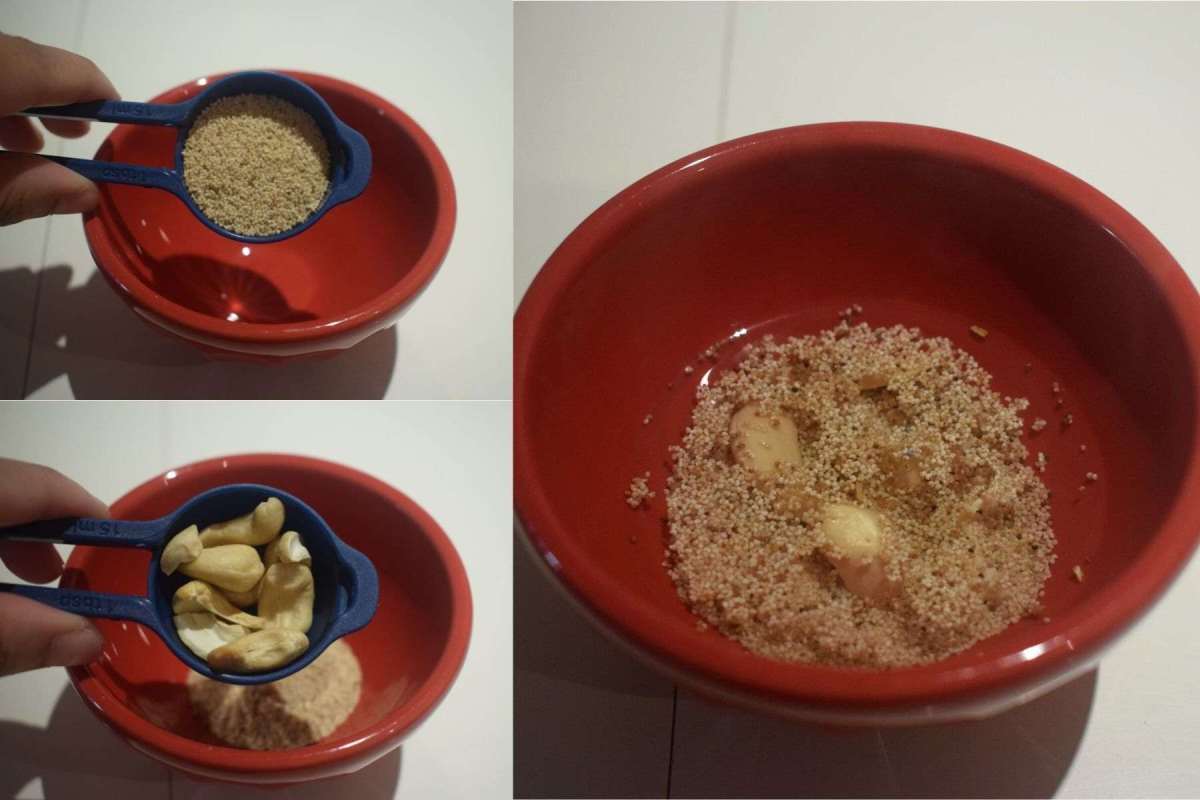
- Strain the water and transfer the content into a jar of a grinder. Add ¼ cup grated fresh coconut and 2 tablespoons of water into it and close the lid. Pulse it to a smooth paste and keep it aside.
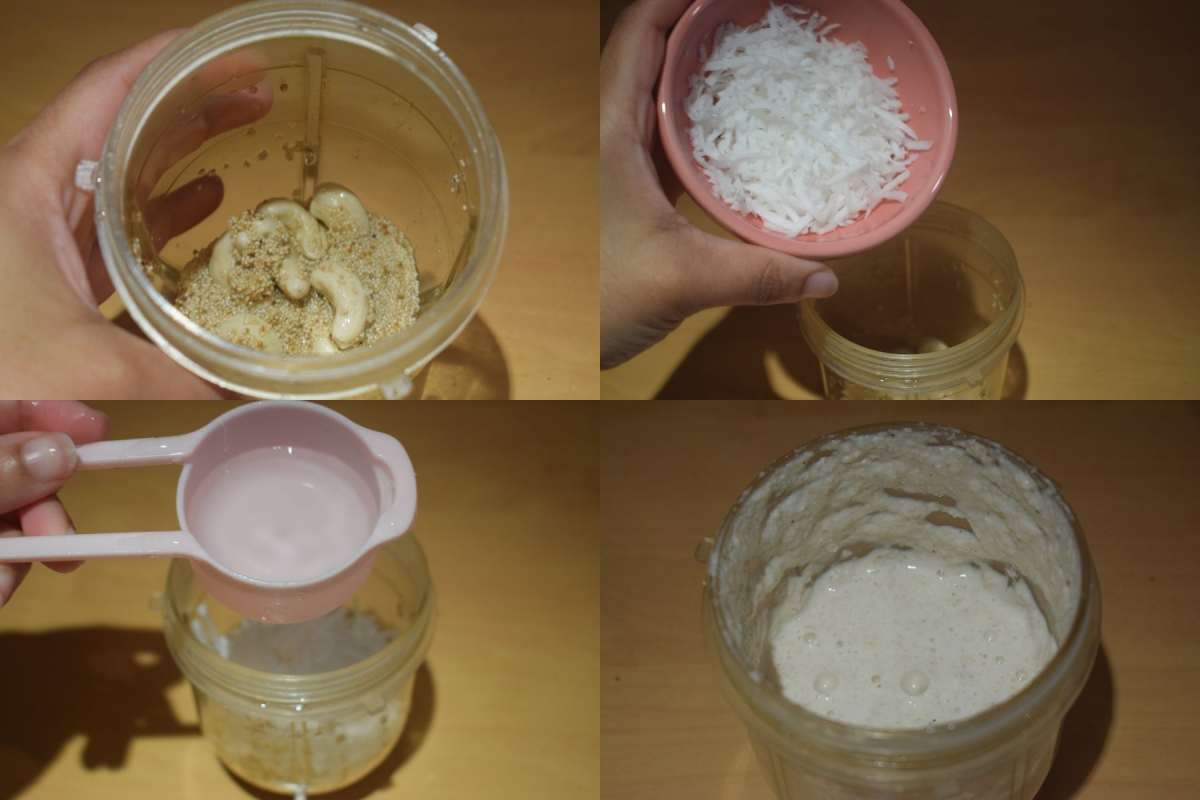
- Take the same jar of the grinder and add tomato chunks and close the lid. Pulse it to a smooth paste and keep it aside.
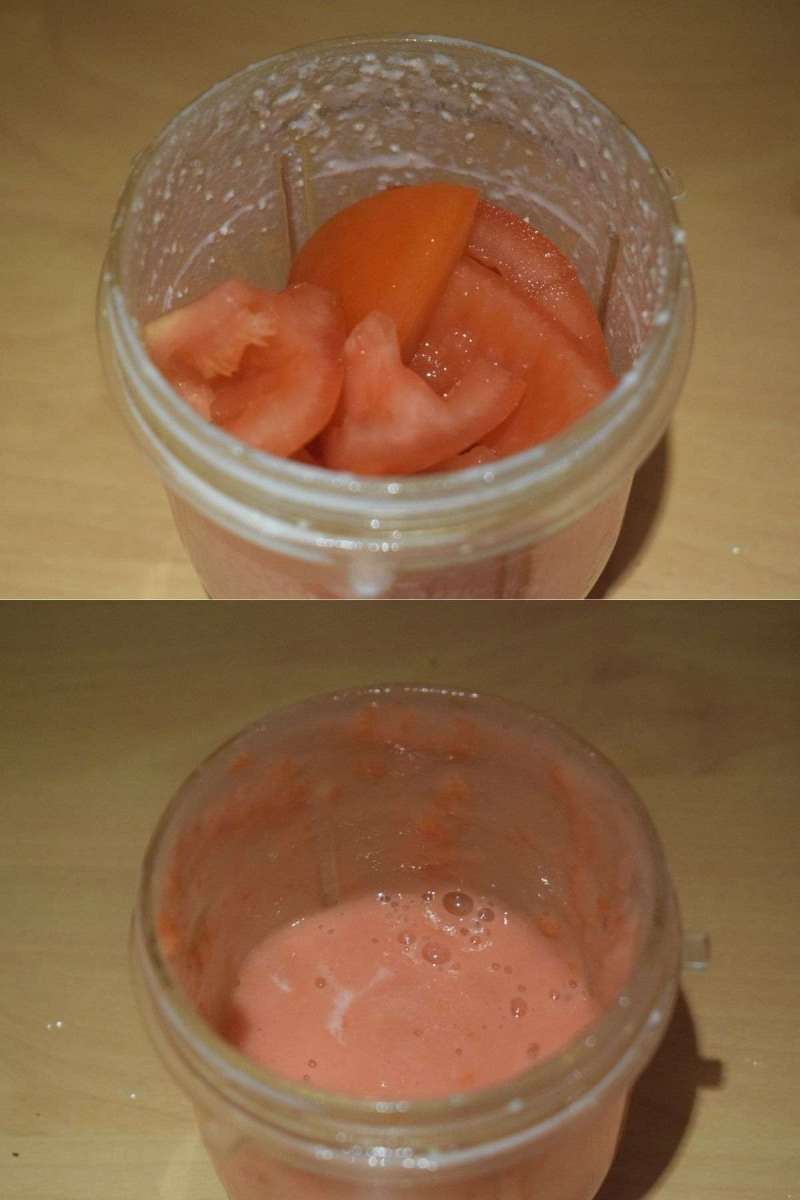
- Put a pan on flame and allow it to become completely dry. Then add 2 tablespoons oil and 1 tablespoon ghee into the pan and wait until it is hot.
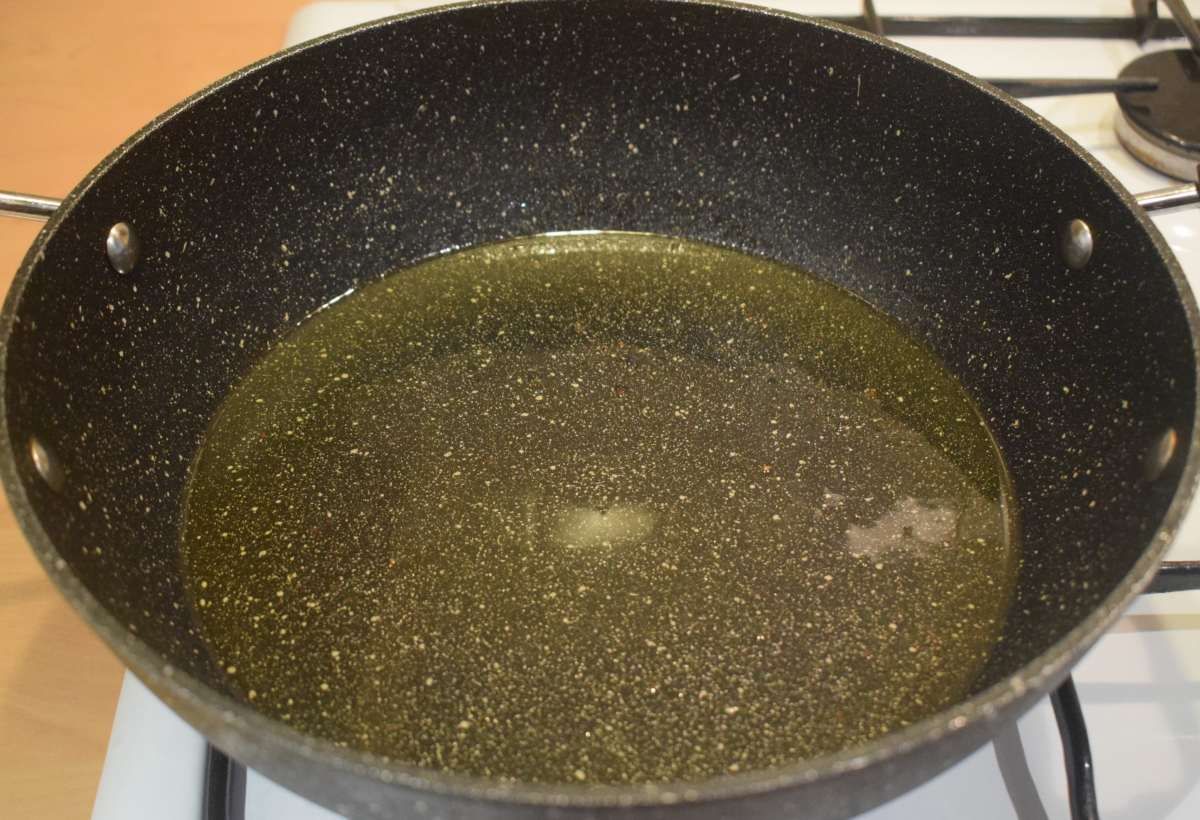
- Add marinated cauliflower florets and fry them over medium-to-medium high flame for around 15 minutes until it loses its crunch and brown spots occur on it. Then strain the cauliflower florets out and keep it aside on a plate.
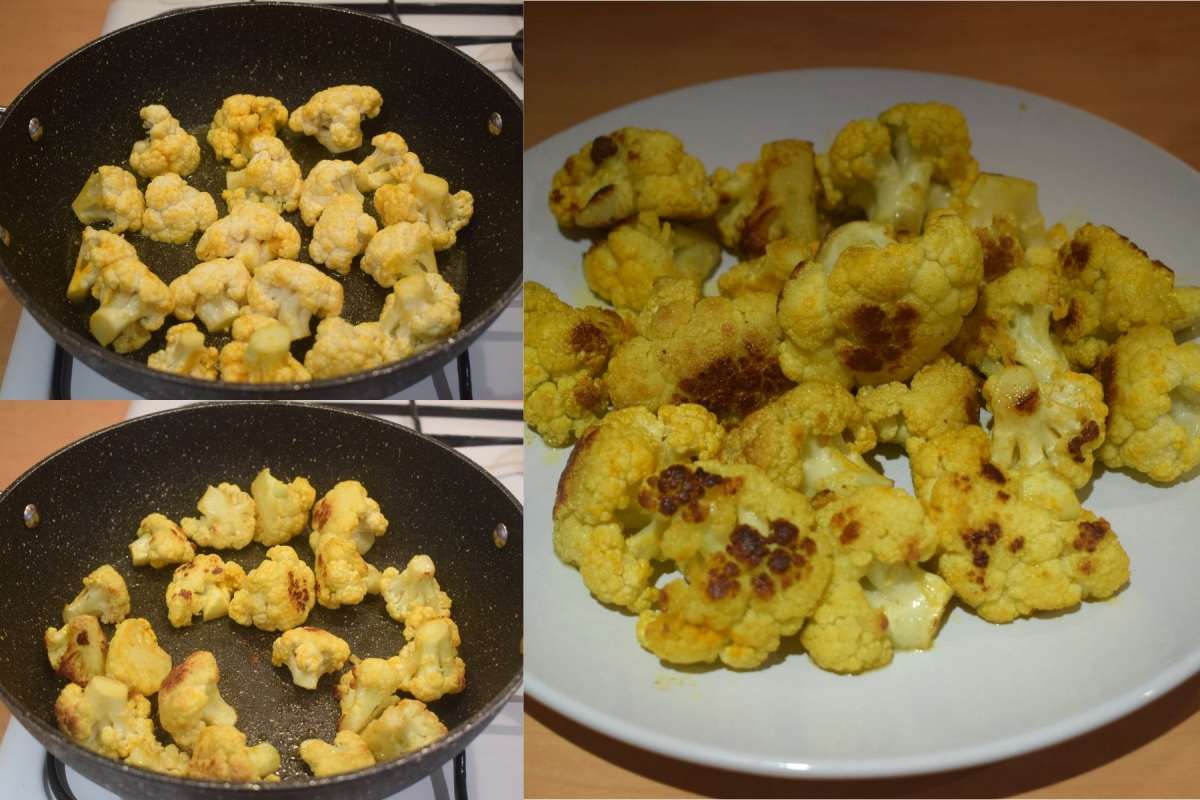
- Add 1 more tablespoon of ghee into the pan and allow it to melt.
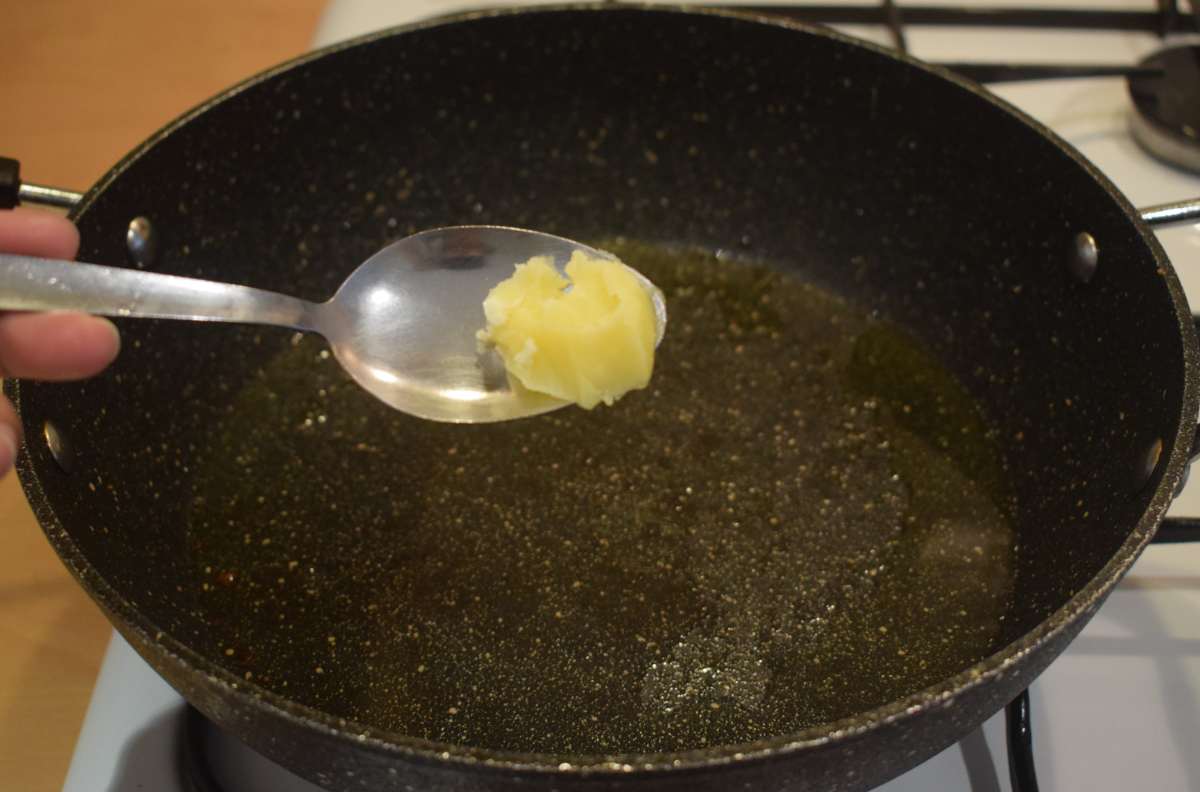
- Once it is hot, add whole spices 1 bay leaf, 4 cloves, 1-inch cinnamon stick, 3cardamoms and let them crackle.
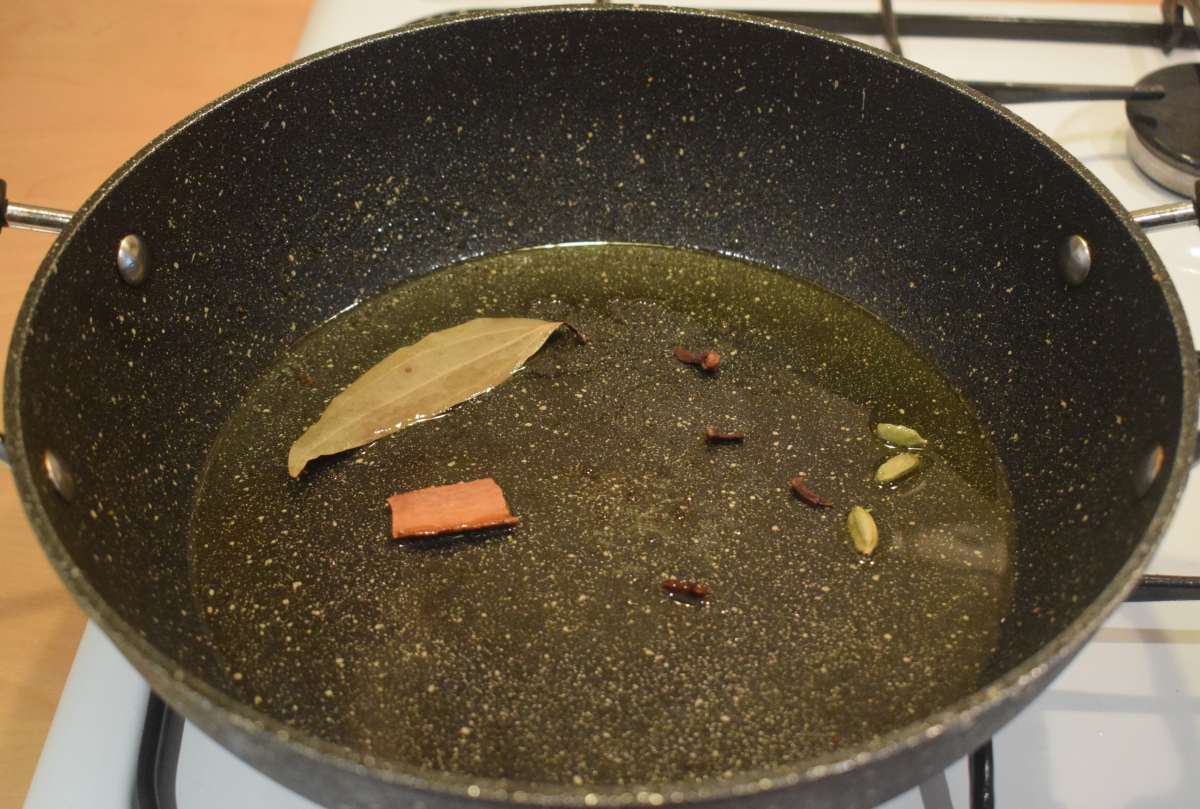
- Add the tomato paste (Step 4) into the pan and give a nice stir. Cook it in medium flame for 3-4 minutes until it releases oil.

- Put the flame in low and add ½ tablespoon ginger paste into the pan. Give a nice mix and cook it for 2-3 minutes until the raw smell of ginger goes away.
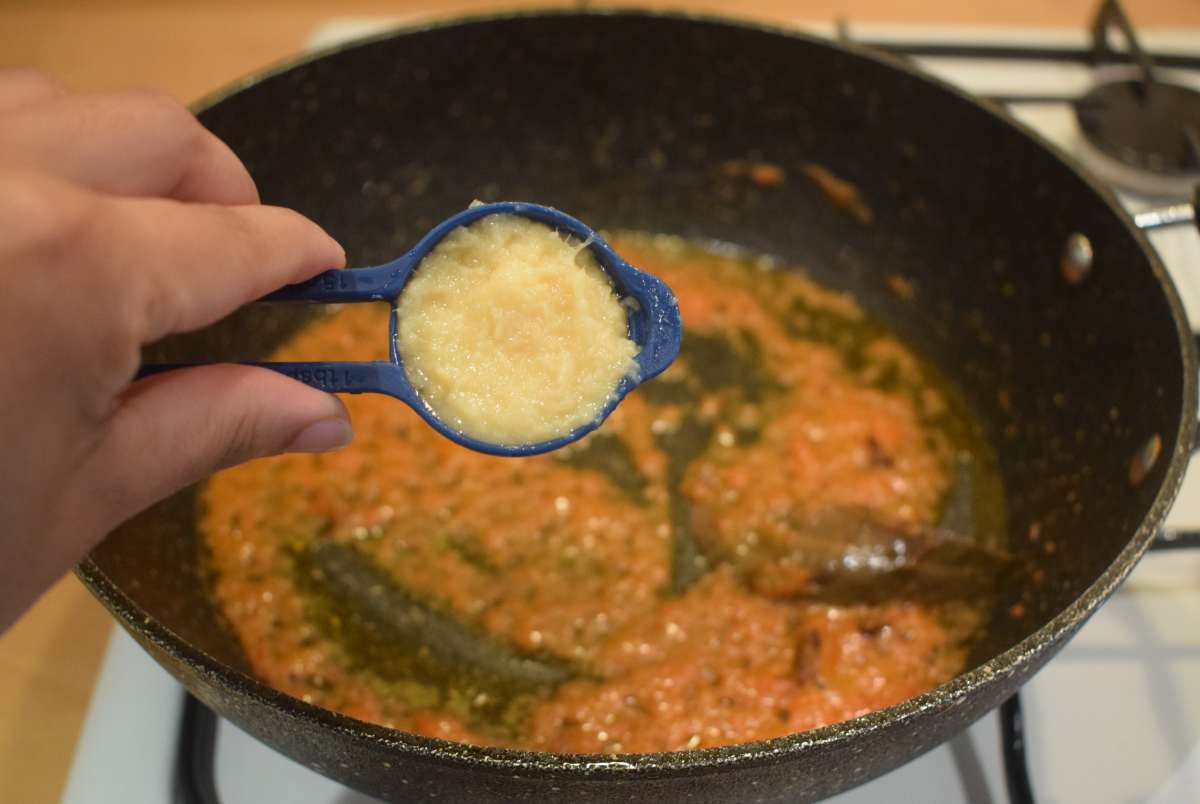
- Add salt, 1 teaspoon turmeric powder, ½ teaspoon red chilli powder and give a nice mix. Cook it in low flame for few more seconds.
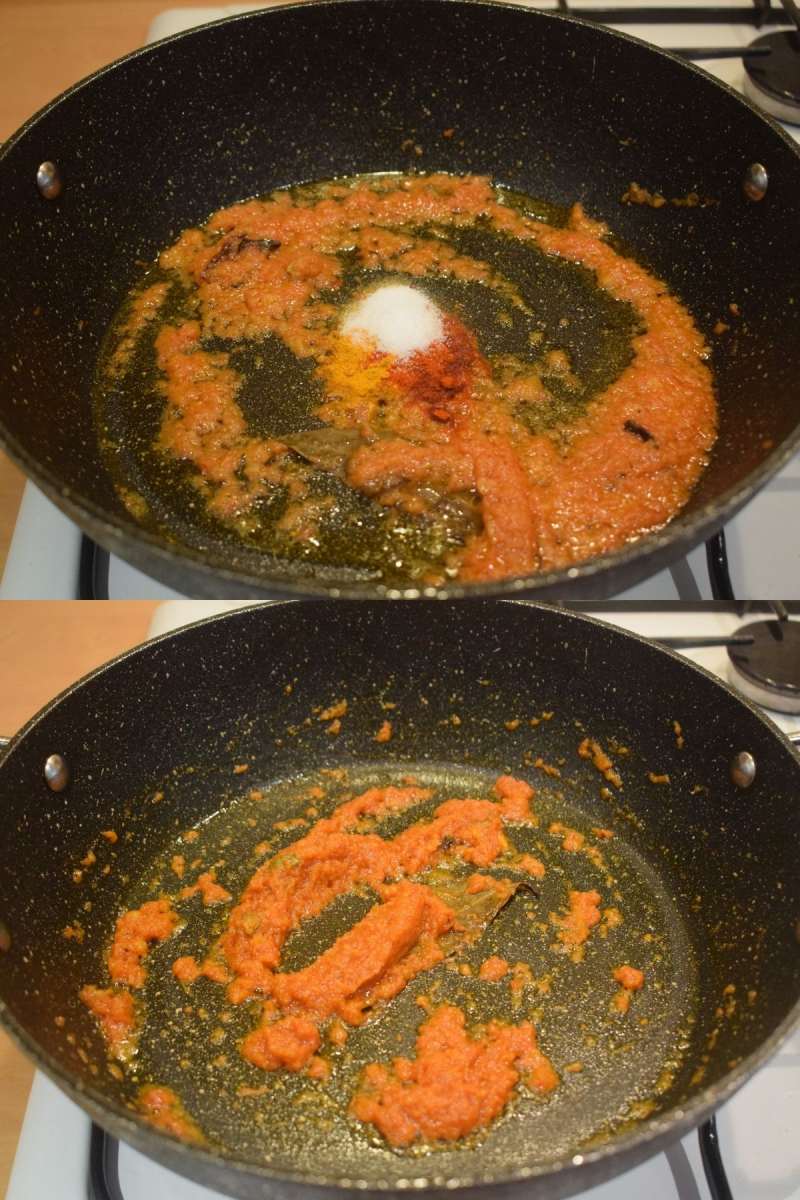
- Put the flame in low and add ¼ cup whipped yogurt into the pan and give a nice mix.
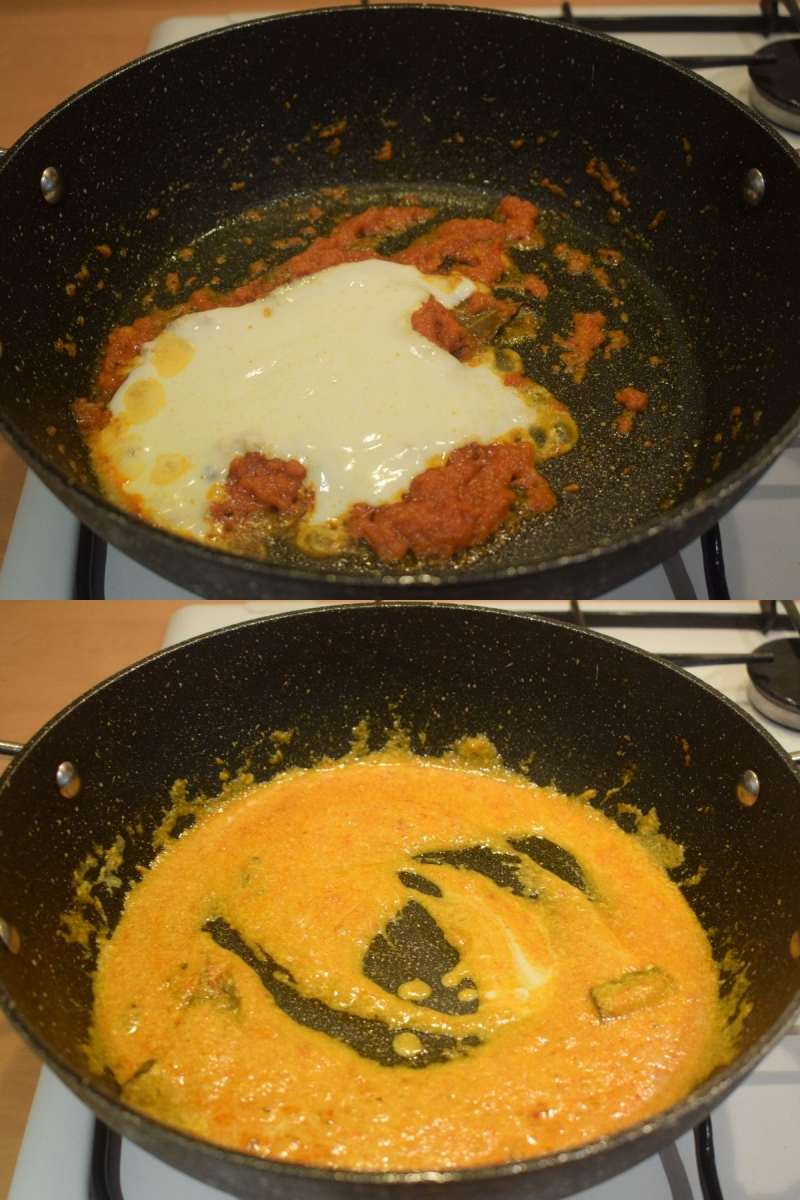
- Add ¼ teaspoon cumin powder and mix it well. Cook it for couple of minutes in low flame until it releases oil.
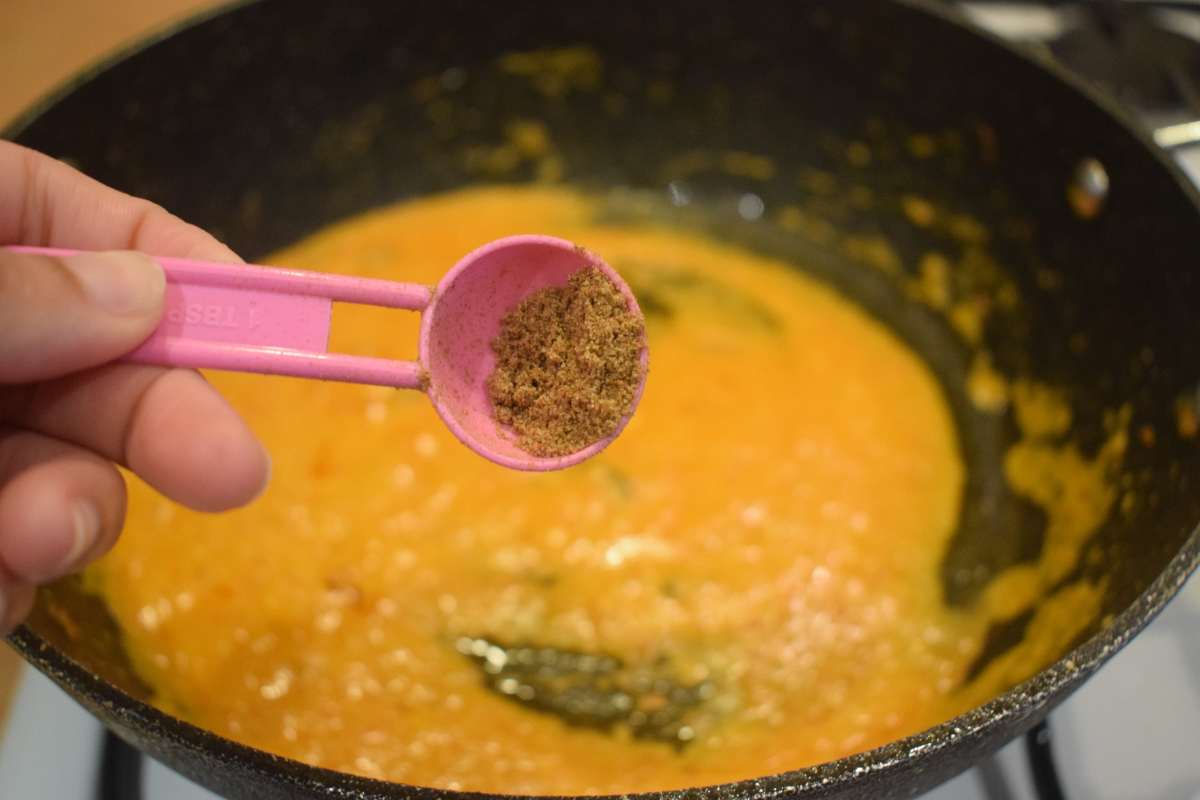
- Add the poppy seeds-coconut paste (Step 3) into the pan and mix it well. Cook it in medium low flame for 6-7 minutes until the masala releases oil. Stir in regular intervals.

- Add ½ cup boiled peas, 1 tablespoon raisin, 3-4 green chillies into the pan and give a nice mix. Cook it in low flame for another couple of minutes.
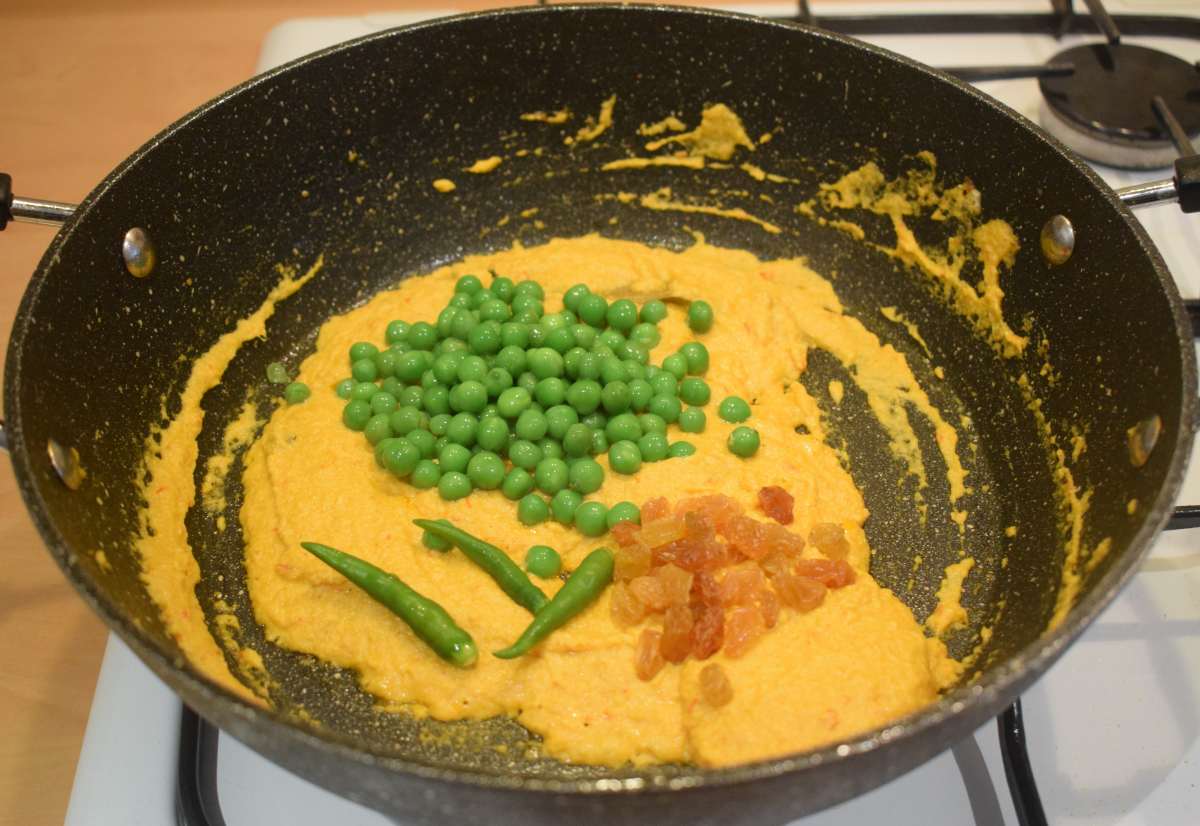
- Add 1½ cups water into the pan for gravy and give a nice stir.
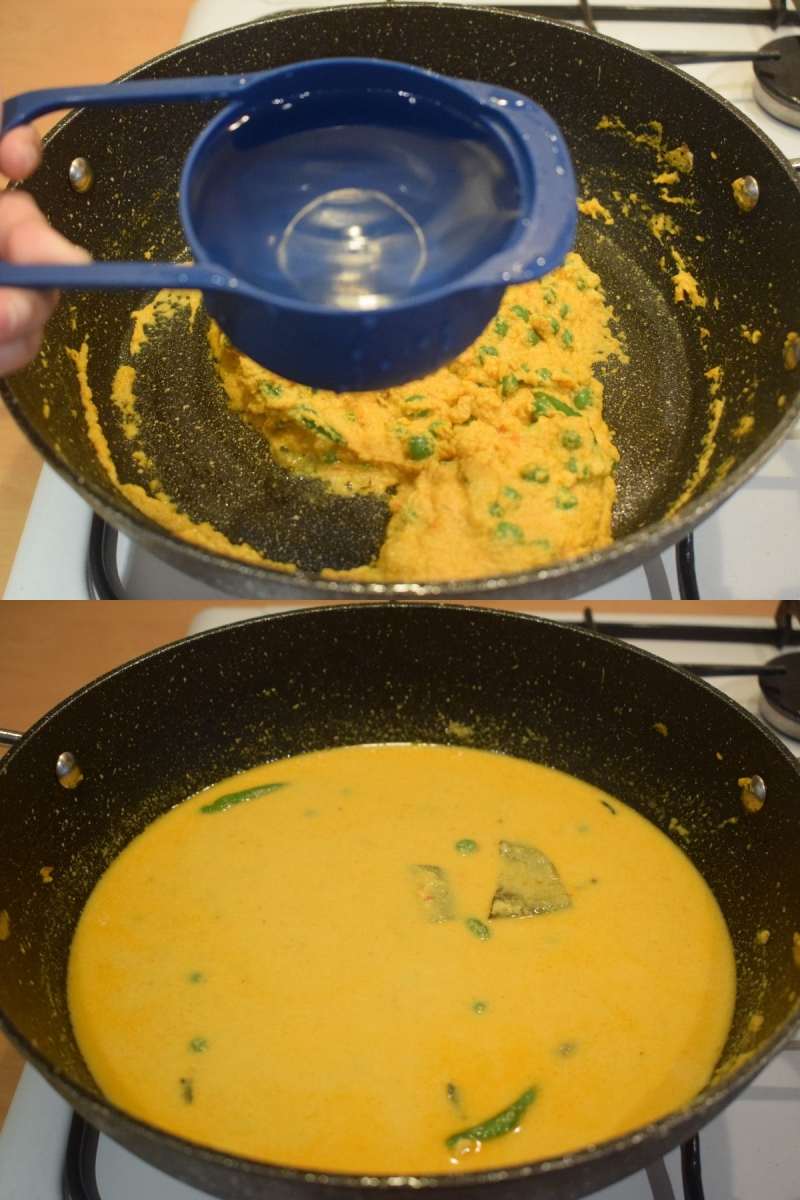
- Add 2 teaspoons sugar and give a nice mix. Put the flame in high until the gravy starts boiling.

- Put the flame in low and add the fried cauliflower chunks (Step 6) into the pan. Cook it for another 10-12 minutes.
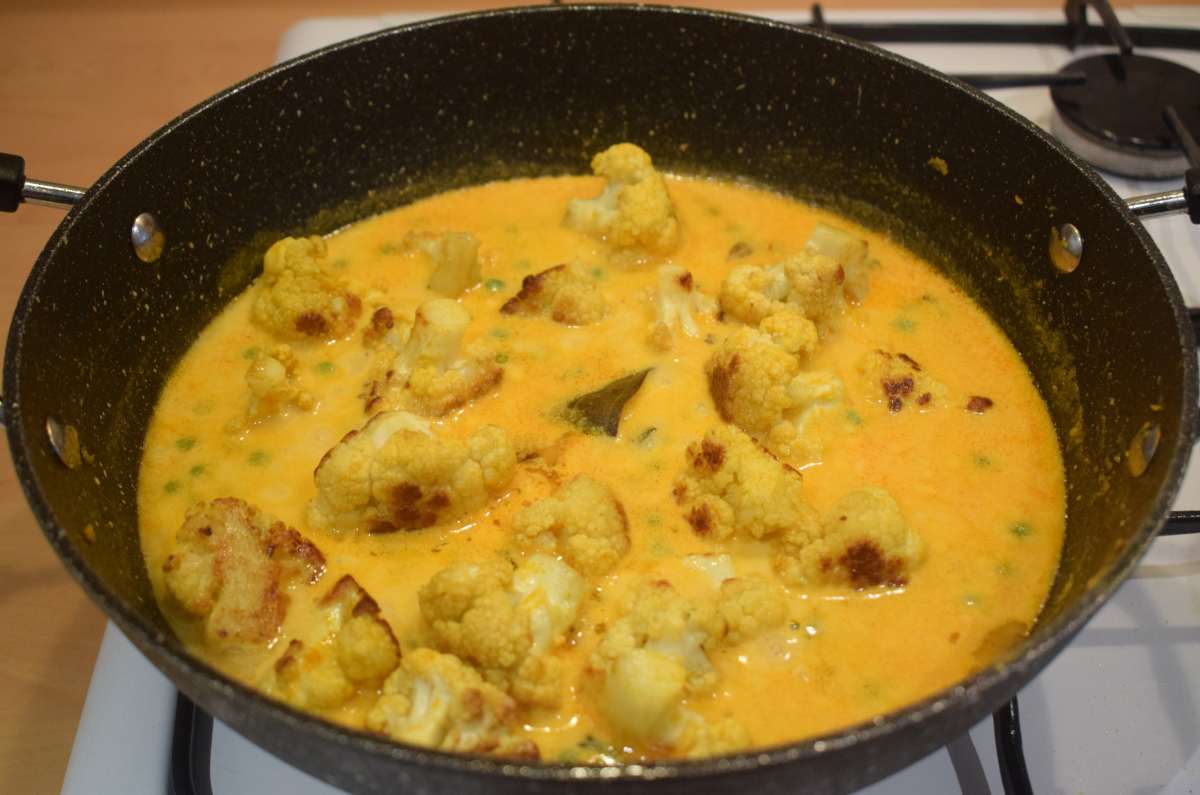
- Add 1 teaspoon bengali garam masala powder and 1 teaspoon ghee (clarified butter), one by one into the pan and give a nice mix.
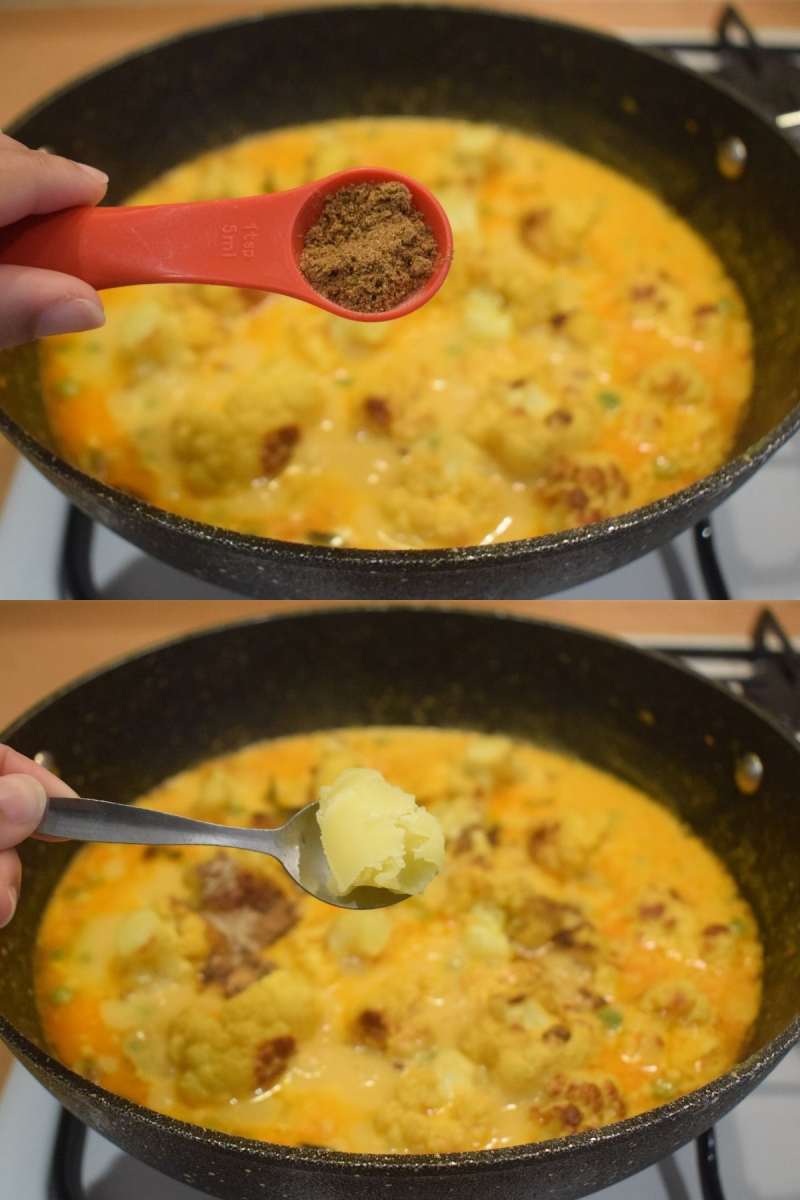
- Simmer the gravy in high flame for another 10-15 more seconds and check the salt of the gravy before switching off the flame. Add more if required and mix it well.
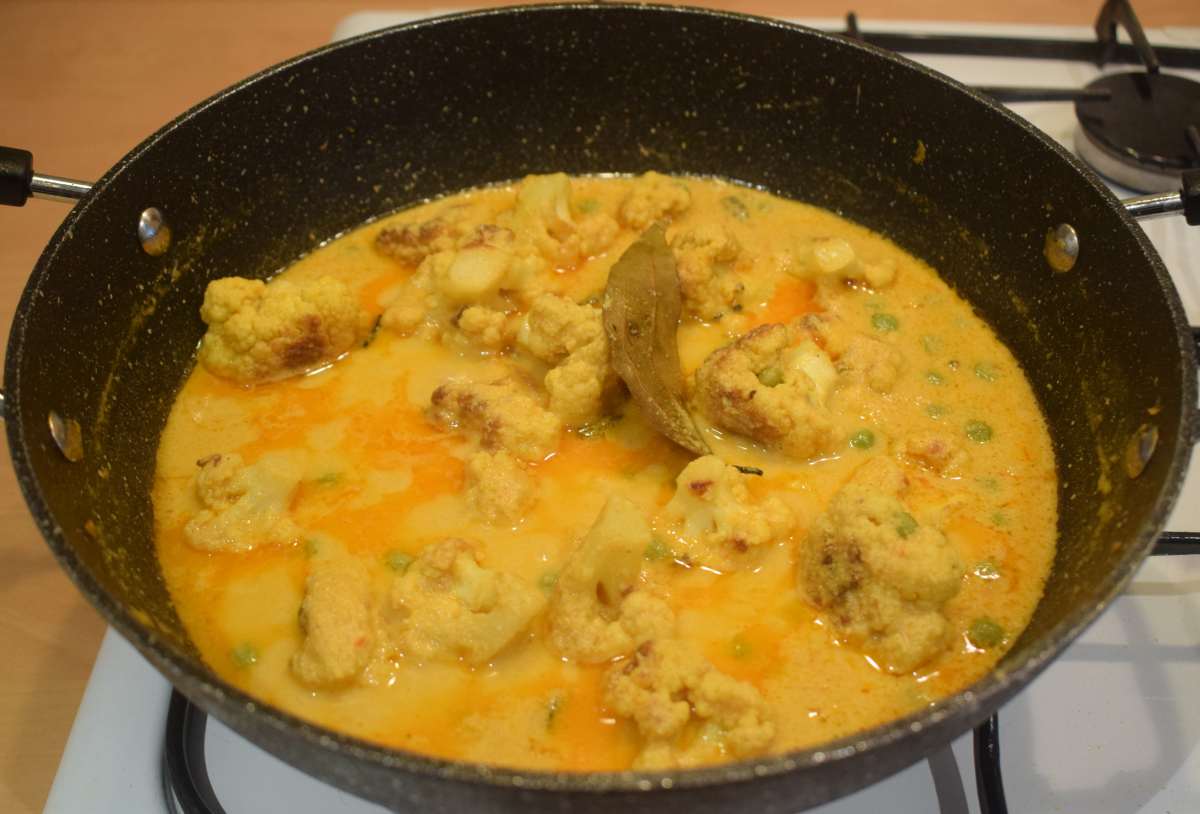
- Switch off the flame.
Serving Instruction
Transfer the phulkopir roast into a serving bowl or on a serving plate. Serve hot or warm to enjoy its best taste. Pair up the luscious dish with rice item like steamed Basmati rice, basanti pulao or flat breads like luchi, rotis, parathas and enjoy the Bengali delight.
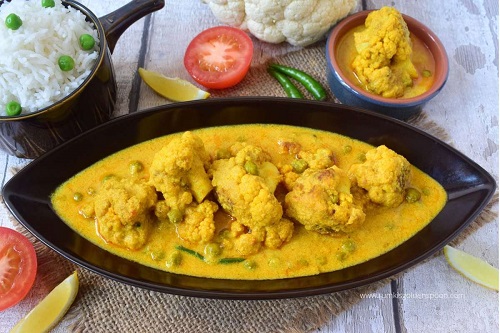
Ingredients
1 cup = 250 ml
To marinate the cauliflower
- 1 medium Cauliflower (Phulkopi), cut into medium florets
- ½ teaspoon Salt
- ½ teaspoon Turmeric powder
For the coconut paste
- 1 tablespoon Poppy seeds (Posto)
- 15 Cashew nuts
- ¼ cup grated Coconut, fresh
- 2-3 tablespoons Water
Other ingredients for Phulkopir roast
- 2 Tomatoes, for paste
- ½ cup boiled green Peas (Optional)
- ½ tablespoon Ginger paste
- 3-4 green Chillies
- 1 tablespoon Raisin
- ¼ cup Yogurt, whipped
- 3 Cardamoms (Elaichi)
- 4 Cloves (Laung)
- 1 inche Cinnamon stick (Dalchini)
- 1 Bay leaf (Tejpatta)
- 1 teaspoon Turmeric powder
- ½ teaspoon red Chilli powder
- ¼ teaspoon Cumin powder
- 1 teaspoon Bengali Garam masala
- 2 teaspoons Sugar, adjust accordingly
- 1 teaspoon Ghee (Clarified butter)
- Salt to taste
- 3 tablespoons Oil for cooking
- 2 tablespoons Ghee (Clarified butter) for cooking
- 1½ cups Water for gravy
Instructions
- Wash and cut the cauliflower florets into medium size even pieces. Add ½ teaspoon salt, ½ teaspoon turmeric powder and mix them evenly so that each cauliflower florets can get coated. Keep it aside.
- On the other hand, soak 1 tablespoon poppy seeds and 15 cashew nuts in hot water for 30 minutes.
- Strain the water and transfer the content into a jar of a grinder. Add ¼ cup grated fresh coconut and 2 tablespoons of water into it and close the lid. Pulse it to a smooth paste and keep it aside.
- Take the same jar of the grinder and add tomato chunks and close the lid. Pulse it to a smooth paste and keep it aside.
- Put a pan on flame and allow it to become completely dry. Then add 2 tablespoons oil and 1 tablespoon ghee into the pan and wait until it is hot.
- Add marinated cauliflower florets and fry them over medium-to-medium high flame for around 15 minutes until it loses its crunch and brown spots occur on it. Then strain the cauliflower florets out and keep it aside on a plate.
- Add 1 more tablespoon of ghee into the pan and allow it to melt.
- Once it is hot, add whole spices 1 bay leaf, 4 cloves, 1-inch cinnamon stick, 3cardamoms and let them crackle.
- Add the tomato paste (Step 4) into the pan and give a nice stir. Cook it in medium flame for 3-4 minutes until it releases oil.
- Put the flame in low and add ½ tablespoon ginger paste into the pan. Give a nice mix and cook it for 2-3 minutes until the raw smell of ginger goes away.
- Add salt, 1 teaspoon turmeric powder, ½ teaspoon red chilli powder and give a nice mix. Cook it in low flame for few more seconds.
- Put the flame in low and add ¼ cup whipped yogurt into the pan and give a nice mix.
- Add ¼ teaspoon cumin powder and mix it well. Cook it for couple of minutes in low flame until it releases oil.
- Add the poppy seeds-coconut paste (Step 3) into the pan and mix it well. Cook it in medium low flame for 6-7 minutes until the masala releases oil. Stir in regular intervals.
- Add ½ cup boiled peas, 1 tablespoon raisin, 3-4 green chillies into the pan and give a nice mix. Cook it in low flame for another couple of minutes.
- Add 1½ cups water into the pan for gravy and give a nice stir.
- Add 2 teaspoons sugar and give a nice mix. Put the flame in high until the gravy starts boiling.
- Put the flame in low and add the fried cauliflower chunks (Step 6) into the pan. Cook it for another 10-12 minutes.
- Add 1 teaspoon bengali garam masala powder and 1 teaspoon ghee (clarified butter), one by one into the pan and give a nice mix.
- Simmer the gravy in high flame for another 10-15 more seconds and check the salt of the gravy before switching off the flame. Add more if required and mix it well.
- Switch off the flame.

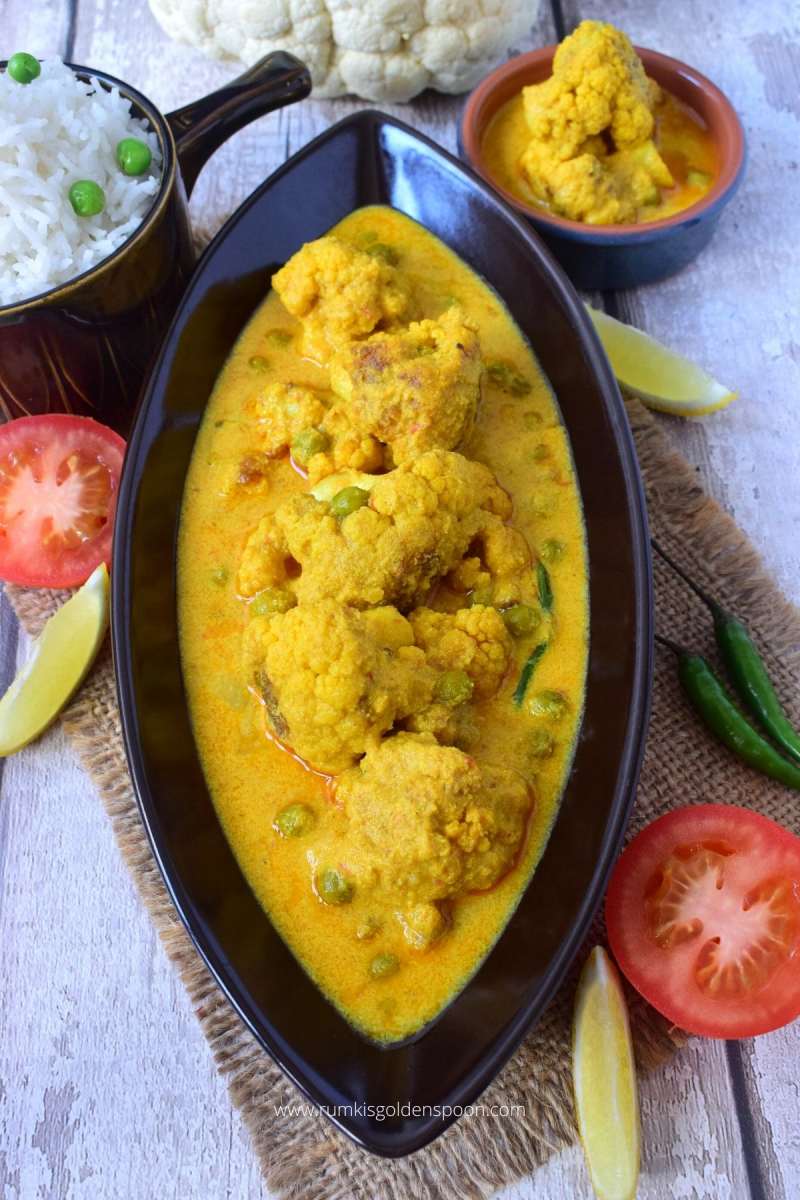
2 comments
[…] Phulkopir roast Chanar Dalna Aloo Posto Shorshe Begun Doi Potol […]
[…] Phulkopir roast Fulkopi posto Aloo phulkopir dalna Phulkopir bora […]